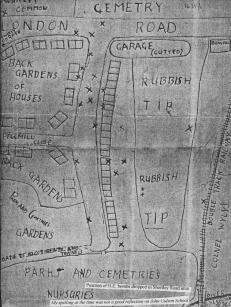

The November14th Coventry Blitz
Facts about the Coventry Blitz, Copyright Maurice Rattigan
Reproduced by Jane Hewitt with kind permission from the author
The Damage
- It was estimated that over a third of the major firms were destroyed or heavily damaged.
- Very few factories escaped with no damage.
- 2,294 houses were destroyed, 5,602 houses were uninhabitable 29,374 houses were damaged but habitable.
- The city housing stock at the time had been 47,998 dwellings.
- 121 shops were destroyed, 131 were badly damaged and 432 suffered slight damage and many churches, cinemas, public houses and garages were destroyed or damaged.
- Two Schools, Cheylesmore and John Gulson, had their upper stories gutted and many more schools were damaged.
- 200 breaks were reported in the water mains and the gas authorities had to deal with 300 major breaks and 2,000 minor ones.
- The telephone system was also severely disrupted but was more easy to repair and was soon up and running again.
- The tramways system was so badly damaged it was abandoned and no further trams ran.
The Casualties
In total there were 1,431 civilian casualties. 568 were killed 863 were severely injured 343 were slightly injured. There were two mass burials at London Road Cemetery.On 20th November 172 were buried and on 23rd November 250 were buried and there were many private funerals.
On 8th April 1941 in a raid on Coventry lasting 6 hours and 50 minutes, 210 tons of bombs were dropped and 281 people were killed.
On 10th April 1941 in a raid lasting 2 hours and 57 minutes, 153 tons of bombs were dropped and 170 people were killed.
There were 41 raids on Coventry when bombs were dropped. The first was on 18th August 1940 and the last was on 3rd August 1942. There were 28 incidents in 1940, 9 in 1941 and 4 in 1942. There were fatalities in 21 of the raids. There was over a 12 month pause from the last raid in 1941 (5th July) and the next raid in 1942 (28th July).
Fire engine equipment at the time was not standardised and some out of town units coming into Coventry that evening found that their hose couplings did not match the local hydrants. Later in the war the National Fire Service (N.F.S.) was formed and introduced standardisation.
Bravery Awards
- Special Constable Brandon Moss was awarded the George Cross.
- George Medals were awarded to 19 year old Betty Quinn, Thomas Lee, Frederick Mason and Albert Fearn.
- Specials Commandant A.F.Matts was awarded the M.B.E. but was tragically killed when the St. Marys Street Main Police Station was received a direct hit on 8th April 1941.
- The Kings Police Medal was awarded to Chief Constable Captain S.A.Hector.
- Head of the W.V.S., Mrs.Pearl Hyde received The M.B.E.
Following the raid, 70 W.V.S. and other voluntary service canteens gave free refreshments to 20,000 people daily. The Midland Daily Telegraph reported that the following March 1,400 builders were repairing 500 houses a day out of a total of between 50,000 and 60,000 that had received some sort of damage.
(Compiled by Maurice Rattigan from information obtained from the Local Studies Section of the Coventry Central Library and from information researched from "Operation Moonlight Sonata", published 1995 by Allan W. Kirki, who obtained much of the German information from Bundesarchiv, Freiburg.)
Quick navigation for Coventry Blitz facts
Quick navigation: Coventry Blitz facts part 1, part 2, part 3
or return to the Coventry Blitz Resource Centre
Coventry: Thursday, 14 November 1940 by Frederick Taylor
Serving as a companion volume to Frederick Taylor s acclaimed Dresden, this is the definitive account of the bombing of Coventry, England on November 14 1940.
And if you look closely in the acknowledgements section, the author generously mentions me and my Family Researcher website.


